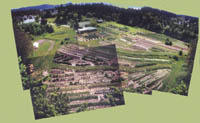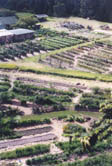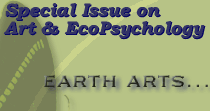|
The
Small Farm as Art Form:
Thoughts on Applied EcoPsychology
(click on the images
to see them bigger)

Robert Greenway
Corona Farm
Port Townsend,
Straits of Juan de Fuca
Washington
"We
receive but what we give,
And in our life alone does Nature live."
~ Samuel T. Coleridge, Art and Nature
It
started out as neither "art" nor "science" --
not an ecopsychology project, nor a subsistence garden. It just
started one day, when I began digging next to the house with a simple
shovel.
I
had noticed water standing most of the winter on our new 6-acre
piece of land, even on the gentle grade that sloped down to the
swale crossing the property diagonally. My first attempts to till
the land with a shovel resulted in the shovel blade being crumpled
at the end. This was an old degraded pasture, perhaps it was always
open land in this dry Olympic rain-shadow portion of the Puget Sound
region. And it was "glacial till" – an almost paving-hard
clay-like layer, scraped of soil by the last glacier's movement
over this country, 10,000 or so years ago. We had giant glacier-dropped
boulders here and there to prove it - but no one could have imagined
the mile-thick layer of ice under which we now labored to create
a "farm".
So, we dug and dug, building up beds of tilth, year after year,
bringing in truckload after truck-load of fish refuse from the local
fish processing plants, and anything else organic we could get our
hands on to compost. (We would get a bed started, scraping up what
soil we could, and then put six inches of compost between the beds,
covering that with newspaper, and that with 6-8 inches of straw,
and each year, after harvest, we would fork the stuff between the
rows into the beds, and thus, after a few years, we ended up with
230 two-foot-high beds of glorious tilth, loaded with worms and
nutrients.

The
garden was not planned in advance, or designed. I simply followed
the contours of the slight slopes, preferring straight lines for
tilling and weeding purposes -- although in retrospect, given the
fact that soil and drainage conditions required raised beds, we
could have curved or jumbled everything up -- creating a more "arty"
garden. What we have overwhelms me at times with its beauty, so
we really don't need anything self-consciously created for the eye
alone. This is a working, commercial garden, or, as we prefer to
call it, "small farm". We named it "Corona Farm"
after the street we're on, fortuitously, and for the energy emanating
from the sun's surface, energy we crave in this cool and often gray
climate. We did not name it after the beer.
We just set out with shovels, and occasional plowing and tilling
from our 85-year-old neighbor with his John Deere tractor - something
powerful enough to pull up a little of the glacial till. Following
the contours meant rows of beds not always at right angles or parallel
to each other. As our available land became "bedded out"
(it took over 5 years of digging, & another 5 years for the
tilth to get "perfect") we began to see a pattern on the
land that astonished us. From the tall "totem tree" (a
100-year-old fir) from neighboring city "surplus" land
we could look down on the property and see the pattern, arrow-shaped,
pointing precisely southwest, towards our cherished Olympic Mountains,
seen in winter through the leafless alder trees.

After
having "seen" that from photographs our young and spry
farm helper took from the top of the tree, it was in our minds as
we walked up and down the rows of beds. We created the pattern,
"unconsciously" -- or, better, from the depths of our
eco-sympathetic consciousness ("follow the contours")
- and once created and brought to awareness, it took us places,
as art can take the mind.
In
a "culture" (made up of individual psyches) alienated
from "nature", nature is seen as "over there",
culture, or "the mind", as "in here". Nature,
outside; culture, inside. This, of course, cannot be literally true,
as our bodily functions, at least, are certainly "nature"
(one reason gardening is often experienced as profoundly erotic).
And there is no place on earth now not influenced by the activities
of humans. But we have created lives that - consciously or not –
presume nature and culture to be separate realms, and we often find
difficulty in joining the realms. And then, in this illusion of
separateness, we act 'as if' it were true; we allow "mental
assumptions" to dominate our relationship with the earth, to
exploit and degrade the natural systems of the earth for short-term
benefit, for wealth, or merely out of a kind of crazed, hungry greed
that more and more obviously functions like an addiction.
Ecopsychology,
whatever it is, is somehow meant to provide a new "cultural
program" to reverse this disastrous state of affairs - a language
that expresses a nature-culture human-nature relationship that is
"sustainable" - not damaging to either, but synergistic
- synergistic for healing and health. It asks the simple but crucial
question: how can humans and nature become happily married, since
we ARE living together; since the idea that we're living in different
realms is a devastatingly spurious idea. Ecopsychology seeks a language
that might help this situation; or it seeks practices that might
move the healing along. Since "nature" was there first
(and most likely "bats last"), it is up to humans to become,
once again, compatible with nature. Though, I'm sure, given nature's
program-from-the-beginning of evolving, of adapting to changes impacting
her, in time, "nature" will change -- is changing -- as
well. Always seeking "balance" and "movement forward"
to some kind of destiny, some "denouement" of all this
turmoil, and emergence -- whatever this great efflorescence of form
and process may or may not mean.
In
fact, art may be a missing link for the development of an ecopsychology
- the emotional response to a form, event, process, experience;
the sense of "fit", of QUERENCIA, of FENG SHUI -- of something
being "just right" without need of further analysis: what
we experience as "perfect". In music, in poetry, in the
colors placed on canvas, in the shape emerging out of wood by the
unmasking of the sculptor's hands.
As
I said, we did not set out to create "art" - but, rather,
a commercial garden, an enterprise loaded (perhaps way too loaded!)
with political and environmentalist implications.
Now
we have this arrow-shaped artifact divided into 230 beds,
in which grow an abundance of food (enough to feed 45 people year
around, 75-80 in summer). From the house, the garden lies to the
southwest, the west, and the northwest. So we track on the patterns
of the sun, knowing which trees mark the northern and southern apogees
of the earth's tilt, marked by the sun's "movement". In
summer, before the bluish gray-green garlic plants have been harvested,
the sun shines through the leaves in early evening (sun doesn't
set here until after 9 P.M. in late June, early July). The sight
of the garlic is mixed with pink-lavender Cosmos, and calendula
spring up from past plantings at the ends of the beds; there's a
long row of lavender from the house, 300 feet to the dark green
fir trees, which also picks up the evening sun. Myriad insects catch
the light as they rise and fall in their spiral dances over the
beds. On market days we're up at first light to harvest or to get
going before the sun is too warm to dig. The length of our days
(plus our night wanderings) have given us a "window" onto
the endlessly varying patterns of light and shadow always moving
across the farm. In other words, we experience VASTLY more on this
little piece of land than we otherwise would have had we just left
it alone.
We
find garlic a tough, adaptive, resilient plant to grow, and we love
our 2+ acres of it, for it brings a good price, is a famous medicine,
and a food of most ethnic groups throughout the world. We grow 22
different varieties - Romanian Red, Asian Tempest, Chinese Pink,
Polish Jenn, German Red, Sicilian Blue and more. Our 300-foot rows
of peonies, iris, and lilies (for our flower business) taking a
different kind of care, but they too are stunningly beautiful "in
their time". We have planted the ends of the beds in Irish
and Scotch "moss" (a rock plant, not a true moss), as
well as Corsican Thyme - it spreads and holds in the beds, and is
incredibly beautiful as well -- especially in winter, when things
are quieted down, waiting for the soil to warm.
On a moonlighted night the garlic communicates, somehow - we hear
voices, and "get ideas" like in a dream, when we walk
down the rows.
If
ecopsychology means anything (and for those using the term to mean
just about anything having to do with human and nature it tends
to mean nothing much at all). if it is to mean anything as it develops,
it will be about relationship - between the "I" and the
"Thou", between humans and nature, culture and nature.
The relationship is not going well, and somehow must be healed.
HOW the relationship got so screwed up – an accurate diagnosis
- is a of course a crucial precursor to healing, as with all medical
healing. And a healing program always involves at least an implicit
vision of what a healed relationship would be like.
We
think of this through the endless hours on our hands and knees "weeding
the beds". We realized quickly that, as with all "love
relationships", the relationship between us and the plants
is one based on the ineffable mystery of love energies. We tend
to accept the Buddhist assumption that the universe -- the underlying
energy of the universe - is synonymous with love, and, when undistorted
and not exploited, is basically GOOD, not evil, or "fallen".
We realize, also, that relationship is not between entities, but
between systems, and when the human-as-system (or culture-as-system)
and "nature-as- system" are fully realized, there is one
system, and there is the relationship. It is a systemic relationship,
through which the energies of mind, nature, the universe, and the
deeper mysteries flow.
Without
being silly about "talking to the garlic", or "hearing
the garlic talk to us", our dominance as ‘creator’
of the garden is softened by the realization that no matter what
we do, we cannot create the basic elements of the farm. We can help,
enhance, even facilitate, but we do not create, and here is the
partnership. Here is the "bridge" between culture and
nature, a partnership further enhanced and validated when the food
we grow passes from our hands to our neighbors.
(I
think these words would apply very accurately to what we call "making
love" as well. Two people find a "flow of energy"
between them, & perhaps if they are lucky, or skilled, they
"merge" these energies. But the "love made"
is not made by the participants - what has been "made"
is a receptacle that allows the basic contextual "love"
of the universe to flow into their lives.)
The
Deep Ecology ideas about "expanded identity", and some
of the ecopsychology writings about "the ecological unconscious"
make sense to us as small-scale farmers only to the degree that
they don't slight the ecological side of the eco-psychology relationship.
For when ecopsychology is weighted with psychology over ecology,
we have simply recreated the pattern of dominance that humans have,
in recent history, presumed to be their privilege if not their manifest
destiny. And so, there it is, the place of change, the place of
healing: truly working in partnership with natural systems, rather
than ignoring them, or whipping them into submission through fertilizers
and pesticides.
We
don't always "plant with the moon" as Alan Chadwick and
the Steinerians taught us some decades ago – but when we don't,
we're aware of it, and do find ourselves leaning in the direction
of lunar planting cycles (supposedly, seedlings grow much better
when planted with the moon waxing) "just in case". We
can pretty accurately predict when the first and last frosts will
come, even in this tempestuous climate. We know the drainage patterns
intimately, the waves of flies and bugs that get into the soil and
eat our carrots. We know which garlic will not rot in the ever-damp
soils of the Northwest, and just how much sun we need to ripen the
tomatoes and corn (usually more than we have!).
It is like living inside an art form, perhaps "performance
art" writ large. It will be a warm sunny summer morning, air
crystal clear from the night winds off the Straits, and we'll hear
the ships coming down the Straits blowing their deep foghorns. We'll
know that later in the day the tongues of fog drifting in will eventually
rise and cool us, up here on the hill. We adjust, accordingly.
Growing
anything is an art, akin to raising a child. You can raise a very
independent garden, or child, or one totally dependent on your efforts
-- with all the attendant resentment that this can bring.
So
small-scale-farming-as-art-farm, like giant sculpture, or towers
made of bottles, or a mile-long stone wall in the hills of Vermont,
is too big to "grasp" - even if it’s just a few acres.
It is ALWAYS ahead of us if we try and "manage" it or
"control" it. If we flow with the systems we depend on,
and utilize local seeds adapted to this kind of weather and soil;
if we provide the plants with things they need that wouldn't naturally
occur - if we do these things, then even the endless "destruction
of the wilderness" that weeding implies seems justified.
For
"nature" - that is, "wilderness", is always
with us. Within just a few years, as has happened all over rural
and suburban America, just a few years of "letting it go",
the garden, the ARTIFACT, will have reverted to wilderness, a natural
ecological progression, whose climax is many generations in the
future. Meanwhile, it seems healing to keep digging, growing, and
feeding ourselves and our neighbors; "making love" with
this piece of the earth that has responded so ..... voluptuously
...... to our efforts.
TRANSPLANTING
Watching hands transplanting,
Turning and tamping,
Lifting the young plants with two fingers,
Sifting in a palm-full of fresh loam, --
One swift movement, --
Then plumping in the bunched roots,
A single twist of the thumbs, a tamping and turning,
All in one,
Quick in the wooden bench,
A shaking down, while the stem stays straight,
Once, twice, and a faint third thump, -
Into the flat-box it goes,
Ready for the long days under the sloped glass:
The sun warming the fine loam,
The young horns winding and unwinding,
Creaking their thin sines,
The underleaves, the smallest buds
Breaking into nakedness,
The blossoms extending
Out into the sweet air,
The whole flower extending outward
Like breast reaching for infant
Stretching and reaching . . .
-Theodore Roethke (from Art and Nature)
Readings
that have entered into our thoughts in the production of this writing:
Callicott, Baird, and Roger Ames, editors, Nature in Asian Traditions
of Thought: Essays in Environmental Philosophy, State University
of New York Press, Albany:1989
Farrell,
Kate, Art and Nature: an Illustrated Anthology of Nature Poetry,
Bullfinch Press (Little, Brown, & Co.), Boston: 1992
Griffin,
Susan, Woman and Nature, Little Brown & Co, N Y.: 1983
Jackson,
Wes, Becoming Native to This Place, Counterpoint Press, Washington
D.C.: 1994
Nabhan,
Gary Paul, Enduring Seeds: Native American Agriculture and Wild
Plant Conservation, North Point Press, San Francisco:1989
Oelschlaeger,
Max, The Idea of Wilderness, Yale University Press, New Haven:
1991
Merchant,
Carolyn, The Death of Nature: Women, Ecology and the Scientific
Revolution, Harper and Row, New York: 1980
Earthcare: Women and the Environment, Routledge Press, New
York:1995
Schama,
Simon, Landscape and Memory, Vintage Books
(Random House), New York: 1995
Shepard,
Paul, Man in the Landscape: A Historic View of the Aesthetics
of Nature, Texas A.& M University Press, College Station:
1967
Silber,
Terry, A Small Farm in Maine, Houghton Mifflin, Boston: 1988
Soule,
Judith D. and Jon K. Piper, Farming in Nature’s Image: an
Ecological Approach to Agriculture, Island Press, Washington
D.C.:1992
Thomas,
Keith, Man and the Natural World: a History of the Modern Sensibility,
Pantheon Books, N.Y.: 1983
Watts,
Alan, Nature, Man and Woman, Pantheon, N.Y.:1957
|





